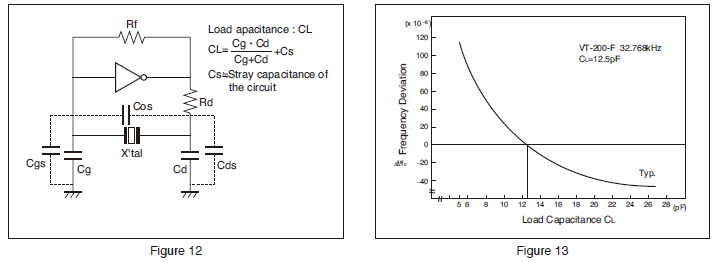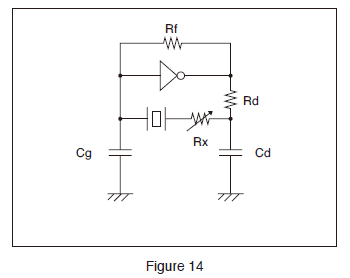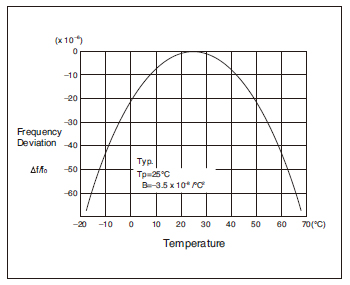Oscillation Circuit Design Overview
Oscillation Circuit Design Key Parameters
DRIVE LEVEL (DL), OSCILLATION FREQUENCY AND LOAD CAPACITANCE (CL), OSCILLATION ALLOWANCE, FREQUENCY-TEMPERATURE CURVE
DRIVE LEVEL (DL)
The drive level of a crystal unit is shown by the level of the operating power or the current consumption (see Figures 9,10, and 11). Operating the crystal unit at an excessive power level will result in the degradation of its characteristics, which may cause frequency instability or physical failure of the crystal chip. Design your circuit within absolute maximum drive level.

OSCILLATION FREQUENCY AND LOAD CAPACITANCE (CL)
The load capacitance (CL) is a parameter for determining the frequency of the oscillation circuit. The CL is represented by an effective equivalent capacitance that is loaded from the oscillation circuit to both ends of the crystal unit (see Figure 12).
The oscillation frequency varies depending upon the load capacitance of the oscillation circuit. In order to obtain the desirable frequency accuracy, matching between the load capacitances of the oscillation circuit and the crystal unit is required. For the use of the crystal unit, match the load capacitances of the oscillation circuit with the load capacitances of the crystal unit.

OSCILLATION ALLOWANCE
 To ensure stable oscillation, the negative resistance of the circuit should be significantly larger than the equivalent series resistance (the oscillation allowance is large). Ensure that the oscillation allowance is at least five times as large as the equivalent series resistance.
To ensure stable oscillation, the negative resistance of the circuit should be significantly larger than the equivalent series resistance (the oscillation allowance is large). Ensure that the oscillation allowance is at least five times as large as the equivalent series resistance.
Oscillation Allowance Evaluation Method
Add resistor “Rx” to the crystal unit in series and ensure that the oscillation starts or stops. The approximate negative resistance of the circuit is the value obtained by adding the effective resistance “Re” to the maximum resistance “Rx” when the oscillation starts or stops after gradually making Rx value larger.
Negative resistance |- R| = Rx + Re
|−R| is a value at least five times as large as the maximum equivalent series resistance (R1 max.) of the crystal unit.
*Re is the effective resistance value during oscillation.
Re = R1 (1 + CO/CL ) 2
FREQUENCY-TEMPERATURE CURVE

Frequency temperature characteristics of tuning fork crystals is shown by negative quadratic curve which has a peak at 25ºC as per left graph.
Please make sure to consider the temperature range and frequency accuracy you need since magnitude of frequency variation becomes larger and larger as the temperature range becomes wider.
[Approximation formula of frequency temperature characteristics]
f_tem = B(T-Ti) 2
B : Parabolic coefficient
T : Given temperature
Ti : Turnover temperature
Click here and jump to “IC matching results with semiconductor manufacturers”.